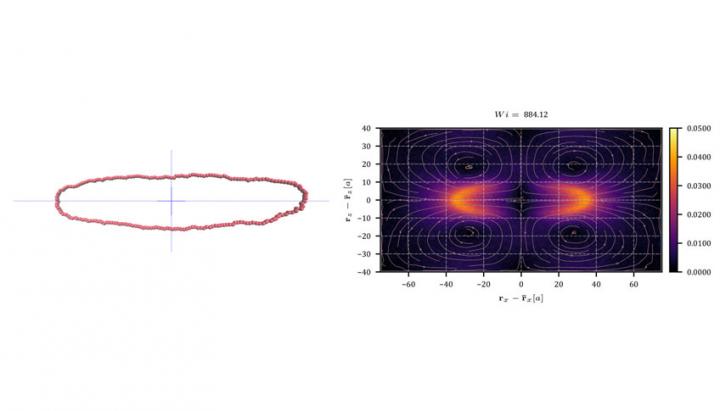Physicists show unique polymer behavior using computer simulations

Credit: © Maximilian Liebetreu
Polymers are long molecules made from periodically connected molecular building blocks called monomers. Some polymers occur naturally in the shape of closed rings – for example as plasmids, cyclic DNA strands in bacteria, or for sufficiently long protein chains. Imagine immersing such objects into a solvent constrained between two parallel plates. We talk about shearing the system when we pull these plates in anti-parallel directions.
Under shear, polymers feature different dynamic modes: “Tumbling” means their swaying and flipping, comparable to the motion of a coin that has been tossed into the air. “Tank-Treading” means the rotation of a polymer ring, comparable to a rolling coin or a bicycle chain. In addition to these modes, rings under shear experience stretching in flow direction, comparable to a stretched rubber band. Like said rubber band, the stretched polymer is under tension. Rotation-, stretching- and alignment behavior were assumed to be the only shear effects on ring polymers – until now.
New movement mode discovered
When simulating these ring polymers, the authors of the study discovered a completely new phase – the so-called “inflation phase”. Above a certain shear velocity, they observed a swelling not only in flow direction, but also in the orthogonal one: the stretched ring “opened”. Furthermore, the ring stabilized itself, tilted in space with respect to the imposed flow. The formerly typical flipping and tumbling were almost completely suppressed. Polymers of a different topological form, such as linear chains, stars and microgels, do not feature any such behavior. When the scientists increased the shear rate further, eventually tumbling set in again, and the polymer aligned with the flow as expected.
The effect becomes even more pronounced when looking at knotted ring polymers. This is best visualized by tying a knot onto a string and then connecting both ends. The knot can then no longer be untied without cutting the string open. Such a knot is pulled tight under shear. In the context of the inflation phase, the scientists found the tight knot serves as a kind of additional stabilization anchor and suppresses tank-treading as well as tumbling.
Polymers can self-stabilize
The team owes their discovery to a simulation method called Multi-Particle Collision Dynamics, which accounts for local vortices and streams. In the specific case of ring polymers under shear, solvent particles are reflected from the stretched ends and the body of the ring. This leads to the collision of two opposite streams of reflected solvent particles in flow direction near the polymer’s center-of-mass. The resulting stream escapes to the sides which causes the ring to open and therefore the observed swelling not only in flow- but also vorticity direction – that is the direction orthogonal to the flow, but parallel to the sheared plates. The resulting flow field relative to the imposed shear is also responsible for the polymer’s self-stabilization.
The observed effect shows the importance of considering hydrodynamic interactions and fluctuations for analyzing the behavior of ring-shaped polymers. The new findings are predicted to be employed in future studies on separation methods for rings of different sizes and polymers of different topological forms.
###
Publication in Communications Materials:
Maximilian Liebetreu and Christos N. Likos
Hydrodynamic Inflation of Ring Polymers under Shear
DOI: 10.1038/s43246-019-0006-5
Media Contact
Christos N. Likos
[email protected]
43-142-777-3230
Original Source
https:/
Related Journal Article
http://dx.




